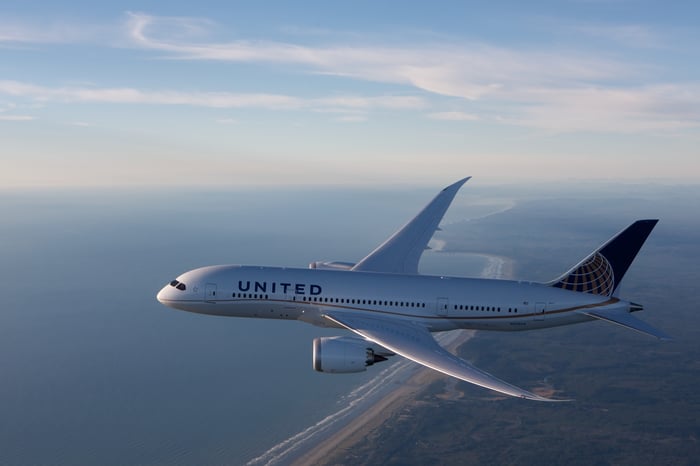In recent months, the four U.S. airlines that fly to Asia -- American Airlines (AAL -0.77%), Delta Air Lines (DAL -1.19%), Hawaiian Holdings (HA), and United Continental (UAL -2.52%) -- have been fighting over who should get the right to operate more flights at Tokyo's Haneda Airport. Haneda is much closer to the city center than Narita Airport, Tokyo's main international airport, which enables airlines to earn a revenue premium on flights there.
Last week, the U.S. Department of Transportation revealed its preliminary allocation of the 12 additional route authorities -- each representing one round-trip flight -- that will become available to U.S. airlines next spring. As expected, each of the four airlines that applied got something. However, Delta was by far the biggest winner, getting five of the 12 available route authorities.
What the airlines wanted -- and what they got
Today, American, Delta, Hawaiian, and United collectively operate six daily round trips to Haneda Airport. American Airlines has a daily flight to Los Angeles; Delta has daily nonstops to Los Angeles and Minneapolis/St. Paul; Hawaiian Airlines has two daily flights to Hawaii; with most of those going to Honolulu; and United operates a daily flight to San Francisco.

Delta currently operates two daily flights to Tokyo's Haneda Airport. Image source: Delta Air Lines.
These four airlines collectively requested 19 additional daily routes. Since this exceeded the 12 incremental route authorities available, the DOT had to make some tough allocation decisions.
American Airlines requested two daily flights to Dallas/Fort Worth, an additional daily flight to Los Angeles, and a daily flight to Las Vegas. Delta wanted to add daily flights to Atlanta, Detroit, Portland, and Seattle, plus twice-daily service to Honolulu. Hawaiian Airlines asked to add three more daily Honolulu flights to its schedule. Finally, United requested daily flights to Chicago, Guam, Houston, Los Angeles, Newark, and Washington, D.C.
Not surprisingly, the DOT looked most favorably on Delta's requests. American Airlines and United Airlines have joint ventures with Japan's two largest airlines (Japan Airlines and ANA, respectively) giving them a big competitive advantage in Japan -- as well as commercial access to additional Haneda flights. Hawaiian is seeking approval for a similar joint venture with Japan Airlines covering the Japan-Hawaii market. Only Delta lacks a local partner in Japan.
Thus, Delta received tentative approval for five of its proposed flights: all but the second daily roundtrip to Honolulu. That will give it seven of the 18 slots reserved for U.S. carriers at Haneda Airport. United will get slots for its Chicago, Los Angeles, Newark, and Washington, D.C. proposals. Hawaiian Airlines will receive one new route authority, enabling its third daily flight to Hawaii. Lastly, American Airlines will be cleared for one daily flight to Dallas/Fort Worth and a second daily Los Angeles flight.

United is set to receive four additional Haneda Airport route authorities. Image source: United Airlines.
The route allocations are still subject to appeal, with a final decision expected over the summer. The new route authorities will become available on March 29, 2020. The airlines are required to start service within 90 days of that date.
The end is near for Delta's Narita Airport hub
When it merged with Northwest Airlines more than a decade ago, Delta acquired a hub at Narita Airport that provided connections between a handful of U.S. gateways and various destinations in Asia. This Tokyo hub had existed since the early 1950s, when aircraft limitations made nonstop service from the continental U.S. to the Asian continent impractical.
In recent years, Delta has gradually dismantled the hub, as a weaker Japanese yen and greater availability of nonstop flights from the U.S. to destinations throughout Asia undermined the Tokyo hub's profitability. Today, Delta operates just seven nonstop routes from Narita Airport, serving Atlanta, Detroit, Honolulu, Portland, Seattle, Manila, and Singapore.
Delta now has tentative clearance to move all five routes to the U.S. over to Haneda Airport. Meanwhile, the routes to Manila and Singapore have become unnecessary because of Delta's new joint venture with Korean Air. Last year, Delta stopped flying to Hong Kong -- a key business destination -- electing instead to route customers via Korean's hub in Seoul. It will probably adopt the same strategy for giving customers access to Manila and Singapore.
Thus, Delta is likely to exit Narita Airport entirely next spring. Dropping the lower-margin routes to Manila and Singapore and moving the five U.S. routes to the more-popular Haneda Airport should drive a massive improvement in the carrier's profitability in Tokyo.
A mixed bag for the other airlines
While Delta was the biggest winner, United Airlines also came away with a nice haul of four additional route authorities. As of next spring, it will be able to fly nonstop to Haneda from five of its domestic hubs. That said, its operation will remain split between Haneda and Narita.
Hawaiian Airlines only got one new Haneda route authority, which may have been disappointing but shouldn't have been surprising. Still, between an extra Haneda flight and the carrier's plan to resume flights to Fukuoka later this year, Hawaiian will be able to shift some capacity from the overcrowded West Coast-Hawaii market to Japan routes with a better supply demand balance.
American Airlines faced the biggest disappointment, as it received only two new Haneda route authorities. This will further reinforce its weakness in Asia compared to its main rivals.
As these new Haneda routes start up next spring -- and some airlines implement corresponding reductions at Narita Airport -- it will be interesting for investors to track the changes in U.S. airlines' unit revenue and profitability in Asia.





